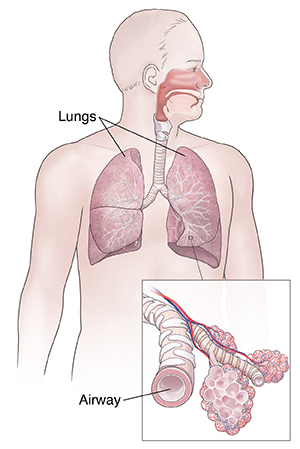Bronchitis is an infection of the air passages. It often occurs during a cold and is caused by a virus. Bronchitis can also be caused by bacterial infection. Symptoms may include a cough with mucus (phlegm), feeling short of breath, and a low-grade fever. This illness can be contagious during the first few days. It's spread through the air by coughing and sneezing. It's also spread by direct contact. This means touching the sick person and then touching your own eyes, nose, or mouth.
If there is a lot of inflammation, air flow is restricted. The air passages may also go into spasms, especially if you have asthma. This causes wheezing and trouble breathing even in people who don't have asthma.
Bronchitis often lasts up to 14 days. The wheezing should improve with treatment during the first week. A bronchodilator is often prescribed. This medicine helps to relax the air passages and stop wheezing. It's very important to use correct techniques when using your bronchodilator.
Antibiotics will also be prescribed if your healthcare provider thinks there is also a secondary bacterial infection. Always follow your provider's instructions when taking these medicines. Take all your medicines as directed. Contact your provider or pharmacist with any questions or concerns about your medicines.
Home care
-
If symptoms are severe, rest at home for the first 2 to 3 days or as advised. When you go back to your normal activities, don't let yourself get too tired.
-
Don't smoke. Ask your healthcare provider for help quitting. Also stay away from secondhand smoke.
-
You may use over-the-counter medicine to control fever or pain, unless another medicine is prescribed. If you have chronic liver or kidney disease or have ever had a stomach ulcer or gastrointestinal bleeding, talk with your healthcare provider before using these medicines. Also talk to your provider if you're taking medicine to prevent blood clots.
Aspirin should never be given to anyone younger than age 18 who is ill with a viral infection or fever. It may cause severe liver or brain damage, or even death.
-
Your appetite may be poor, so a light diet is OK. Stay hydrated by drinking 6 to 8 glasses of fluids per day (such as water, soft drinks, sports drinks, juices, tea, or soup). Extra fluids will help loosen secretions in the nose and lungs.
-
Over-the-counter cough, cold, and sore-throat medicines will not shorten the length of the illness. But they may help reduce symptoms. If you have high blood pressure, don't use decongestants without your provider's permission.
If you take other prescribed medicines, contact your provider to discuss over-the-counter medicines before taking them.
-
If you were given an inhaler (bronchodilator), use it exactly as directed. If you need to use it more often than prescribed, your condition may be getting worse. If this happens, contact your healthcare provider.
-
If prescribed, finish all antibiotic medicine, even if you feel better after only a few days.
Follow-up care
Follow up with your healthcare provider, or as advised. If you had an X-ray or ECG (electrocardiogram), you'll be told of any new findings that may affect your care.
Take steps to prevent future infections. Ask your healthcare provider about the pneumococcal vaccines and a yearly flu shot. There are 2 kinds of pneumococcal vaccines. You may need both. You’re at higher risk of lung infection if any of these apply to you:
-
If you are older
-
If you have a chronic lung disease
-
If you have condition that affects your immune system
-
If you smoke
When to get medical advice
Call your healthcare provider right away if any of these occur:
-
Fever of 100.4°F (38°C) or higher, or as directed by your provider
-
Coughing up more colored sputum
-
Face or ear pain
-
Mild weakness, drowsiness, headache, or a stiff neck
Call 911
Call
-
Coughing up blood
-
Worsening weakness, drowsiness, headache, or stiff neck
-
Increased wheezing not helped with medicine, shortness of breath, or pain with breathing
-
Feeling of doom
-
Feeling dizzy
-
Unable to respond or talk
-
Lips or skin looks blue, purple, or gray


